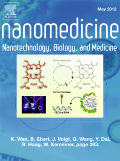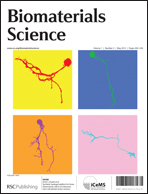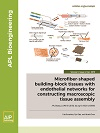
Nanomedicine-Nanotechnology Biology and Medicine
Scope & Guideline
Pioneering Research in Nanomedicine for a Healthier Tomorrow
Introduction
Aims and Scopes
- Nanoparticle Development for Drug Delivery:
Research on the design and synthesis of nanoparticles for targeted drug delivery systems, enhancing the bioavailability and therapeutic efficacy of various drugs. - Nanotechnology in Cancer Treatment:
Exploration of nanomedicines and their applications in cancer therapy, focusing on mechanisms of action, efficacy, and safety in clinical settings. - Biocompatibility and Safety Assessments:
Evaluation of the biocompatibility and safety of nanomaterials used in biomedical applications, including toxicity studies and regulatory considerations. - Innovative Diagnostic Techniques:
Development of nanoparticle-based diagnostic tools and imaging techniques aimed at early disease detection and monitoring, including the use of biosensors and imaging agents. - Theranostic Applications:
Integration of therapeutic and diagnostic capabilities in nanomedicine, allowing for simultaneous treatment and monitoring of disease progression. - Nanomaterials for Regenerative Medicine:
Use of nanotechnology in tissue engineering and regenerative medicine, focusing on scaffolds, drug delivery systems, and cellular interactions.
Trending and Emerging
- Nanoparticle-Enabled Immunotherapy:
An increasing number of studies focus on the use of nanoparticles to enhance immunotherapy, indicating a growing interest in integrating nanotechnology with immune modulation for cancer treatment. - CRISPR and Gene Editing Technologies:
Research involving nanoparticles for gene editing applications, particularly CRISPR/Cas9 delivery systems, is on the rise, showcasing the potential of nanotechnology in genetic therapies. - Microfluidics for Nanoparticle Synthesis:
The application of microfluidic technologies for the synthesis and characterization of nanoparticles is emerging as a significant trend, providing precise control over particle properties and functions. - Extracellular Vesicles as Nanocarriers:
A growing body of work is exploring the use of extracellular vesicles derived from cells as natural nanocarriers for drug delivery, highlighting advancements in biocompatible and targeted therapies. - Personalized Nanomedicine:
There is an increasing trend towards personalized approaches in nanomedicine, with research focusing on tailoring nanoparticle formulations based on individual patient profiles and disease characteristics. - Nanotechnology for Chronic Disease Management:
Emerging studies are increasingly targeting chronic diseases, such as diabetes and cardiovascular conditions, using nanotechnology for improved therapeutic outcomes and monitoring.
Declining or Waning
- Traditional Small Molecule Drug Delivery Systems:
Research focusing on conventional small molecule drug delivery methods is becoming less prevalent, as the field shifts towards more innovative, nanoparticle-based approaches. - Invasive Surgical Techniques:
The exploration of invasive techniques in conjunction with nanotechnology is waning, with a greater emphasis on non-invasive or minimally invasive approaches using nanomaterials. - Single-Modal Therapies:
There is a noticeable decline in studies dedicated solely to single-modal therapies, as the field moves towards combination therapies that integrate nanotechnology with immunotherapy or other modalities. - Basic Physicochemical Characterization:
While foundational studies are important, there is a diminishing focus on basic physicochemical characterization of nanoparticles without direct applications, as researchers prioritize functional and therapeutic outcomes.
Similar Journals

Bioengineering-Basel
Elevating Bioengineering Knowledge GloballyBioengineering-Basel, an esteemed journal published by MDPI, stands at the forefront of innovation in the field of bioengineering since its inception in 2014. With an E-ISSN of 2306-5354, this fully Open Access journal based in Switzerland provides a platform for researchers and professionals to disseminate cutting-edge findings across various aspects of bioengineering, including biomaterials, tissue engineering, and biopharmaceuticals. The journal has been recognized with a Q3 ranking in the 2023 Bioengineering category, reflecting its commitment to quality and relevance. By facilitating widespread accessibility to academic knowledge, Bioengineering-Basel aims to foster collaboration and stimulate thought leadership within the global research community, making it an indispensable resource for students, scholars, and industry practitioners alike.

Cancer Nanotechnology
Unlocking the Potential of Nanotechnology in OncologyCancer Nanotechnology is a cutting-edge peer-reviewed journal dedicated to advancing the field of cancer research through innovative nanotechnology applications. Published by SPRINGER WIEN, this open-access journal, established in 2010, provides a vital platform for the dissemination of high-quality research with a focus on the intersection of nanotechnology, oncology, and biomedical engineering. With a commitment to promoting accessibility and fostering collaboration, Cancer Nanotechnology has gained impressive rankings within specialized categories, including Q2 in Biomedical Engineering and Pharmaceutical Science. The journal's rigorous selection process ensures that only the most impactful studies reach its audience, making it a must-read for researchers, professionals, and students eager to explore the latest advancements and methodologies in cancer treatment. With its scope encompassing critical topics that bridge multiple disciplines—including physical chemistry and toxicology—Cancer Nanotechnology positions itself as an influential resource for shaping the future of cancer therapies.

Biomaterials Science
Uniting academia and industry to revolutionize biomaterials science.Biomaterials Science is a premier journal published by the Royal Society of Chemistry that serves as a leading platform for researchers and professionals in the fields of Biomedical Engineering and Materials Science. With an impressive impact factor bolstered by its Q1 quartile ranking in both disciplines, this journal has positioned itself at the forefront of cutting-edge research, showcasing innovative materials and applications that drive advancements in healthcare and technology. Since its inception in 2013, Biomaterials Science has been committed to disseminating high-quality, peer-reviewed articles that promote scientific knowledge and collaboration among academia and industry. With a global readership and a focus on open access, researchers are encouraged to share their findings to facilitate the development of transformative biomaterials and their applications. Join a vibrant community of scholars as we explore the future of biomaterials through this esteemed publication, enhancing both scientific inquiry and practical application.

Journal of Reports in Pharmaceutical Sciences
Transforming Insights into Impactful Pharmaceutical Solutions.Journal of Reports in Pharmaceutical Sciences is a pivotal publication in the realm of pharmaceutical research, disseminating innovative findings that cater to the evolving landscape of pharmacology, toxicology, and biomedical engineering. Published by Wolters Kluwer Medknow Publications, the journal serves as a bridge for scholars and practitioners aiming to enhance their understanding of drug development, therapeutic advances, and biopharmaceutical technologies. With an ISSN of 2322-1232 and E-ISSN 2322-5106, it has established its relevance from 2012 to 2022, occupying notable quartile rankings, including Q3 in Pharmacology, Toxicology, and Pharmaceutics. Despite being categorized in Q4 in some areas, the journal's commitment to quality research ensures it remains a respected platform for disseminating significant insights. Researchers, professionals, and students alike will find this journal an indispensable resource for staying updated on critical advancements in pharmaceutical sciences, making it a go-to source for impactful studies that shape industry practices and academic inquiries.

Regenerative Biomaterials
Advancing the Future of RegenerationRegenerative Biomaterials, published by Oxford University Press, serves as a premier platform for the dissemination of innovative research in the rapidly evolving field of biomaterials. Since its inception in 2014, this esteemed open-access journal has fostered a collaborative and diverse scientific community, providing free access to impactful articles that enhance our understanding of regenerative medicine and tissue engineering. With a commendable impact factor and ranking within the top quartiles of both Biomedical Engineering and Materials Science, it is recognized for its rigorous peer-review process and high-quality publications. The journal aims to bridge the gap between fundamental research and applied sciences, promoting advanced studies that contribute to clinical applications and regeneration strategies. Researchers, practitioners, and students alike are encouraged to engage with the journal’s content to foster interdisciplinary collaboration and drive future innovations in the biomaterials domain.

Progress in Biomedical Engineering
Innovative insights for cutting-edge biomedical breakthroughs.Progress in Biomedical Engineering, published by IOP Publishing Ltd, is a premier open-access journal that serves as a vital platform for the dissemination of innovative research in the field of biomedical engineering. With an impressive Q1 classification in the Biomedical Engineering category for 2023, this journal has established itself as a significant contributor to the advancement of engineering solutions that improve healthcare outcomes. Recognized for its high-quality and impactful publications, it ranks 51st out of 303 in its field on Scopus, placing it in the 83rd percentile. The journal aims to foster interdisciplinary collaboration and introduce pioneering methodologies and technologies that bridge the gap between engineering and medicine. By providing a pathway for rapid communication of fundamental and applied research, Progress in Biomedical Engineering is dedicated to shaping the future of healthcare technology. Access to its content ensures that researchers, professionals, and students remain at the forefront of biomedical innovation.

Biomedical Materials
Shaping Tomorrow's Healthcare with Cutting-Edge Materials.Biomedical Materials, published by IOP Publishing Ltd, is a premier journal dedicated to the rapidly evolving field of biomedical engineering and materials science. With a robust impact factor showcasing its influence, this journal serves as a vital platform for disseminating pioneering research from 2006 to 2024. Covering an array of interdisciplinary topics—ranging from biomaterials to bioengineering and applied chemistry—the journal consistently ranks in the second quartile across multiple categories including Bioengineering (Q2), Biomaterials (Q2), and Biomedical Engineering (Q2) as of 2023. Researchers, professionals, and students alike benefit from its contributions, exploring innovative solutions at the intersection of biology and material science. Although not an Open Access journal, Biomedical Materials remains essential in advancing our understanding and facilitating discussions surrounding state-of-the-art materials that revolutionize medical applications and enhance patient care.

APL Bioengineering
Exploring New Frontiers in Bioengineering ResearchAPL Bioengineering is a premier open-access journal published by AIP Publishing, dedicated to advancing the field of bioengineering and its interdisciplinary applications. Established in 2017, this journal serves as a vital platform for researchers, professionals, and students interested in the critical intersections of bioengineering, biomaterials, biomedical engineering, and biophysics. With an impressive impact factor and consistent rankings in the Q1 category across multiple domains, including biochemistry and materials science, APL Bioengineering has positioned itself among the top journals in its field. The journal aims to publish innovative original research, comprehensive reviews, and insightful case studies that further the understanding and application of bioengineering principles. Since its inception, APL Bioengineering has fostered a community of thought leaders, providing open access to ensure broad dissemination of knowledge and advancements that underpin the future of biomedical innovation.

Nanotechnology Science and Applications
Bridging Science and Application in Nanotechnology.Nanotechnology Science and Applications, published by DOVE MEDICAL PRESS LTD, is a premier open-access journal dedicated to advancing knowledge in the fields of nanoscience and nanotechnology, particularly focusing on their applications in bioengineering, biomedical engineering, and pharmaceutical sciences. Since its inception in 2008, this journal has provided a platform for the dissemination of high-quality research that is rigorously peer-reviewed, ensuring that only the most impactful findings reach a global audience. With an impressive impact factor reflected in its recent categorization in the Q1 tier for Pharmaceutical Science and Q2 for Bioengineering and Nanoscience, it stands as a critical resource for researchers, practitioners, and students eager to explore the cutting-edge innovations within these rapidly evolving disciplines. The journal's commitment to accessibility and its robust indexing in Scopus—ranked highly in its respective categories—reinforces its importance as a leading forum for the exchange of scientific knowledge and the fostering of collaborative research in nanotechnology applications.

BioChip Journal
Pioneering Research at the Intersection of Bioengineering and TechnologyBioChip Journal, published by the Korean Biochip Society (KBCS), is a renowned academic platform dedicated to advancing the fields of bioengineering, biomedical engineering, biotechnology, and electrical and electronic engineering. With its ISSN 1976-0280 and E-ISSN 2092-7843, this esteemed journal has established itself as a valuable resource for researchers, professionals, and students alike, providing them with cutting-edge research and insights since its inception in 2008. The journal has earned a commendable standing in the academic community, achieving Q2 ranking across key categories, thereby placing it amongst the top-tier publications. With its impressive Scopus rankings, including a top 10% position in Electrical and Electronic Engineering and a strong showing in both Biomedical Engineering and Biotechnology, BioChip Journal plays a vital role in disseminating innovative biochip technologies and applications. The journal continues to invite groundbreaking studies and reviews that promote the interdisciplinary collaboration essential for the future of biochip research, ultimately contributing to advancements in healthcare, diagnostics, and therapeutics.